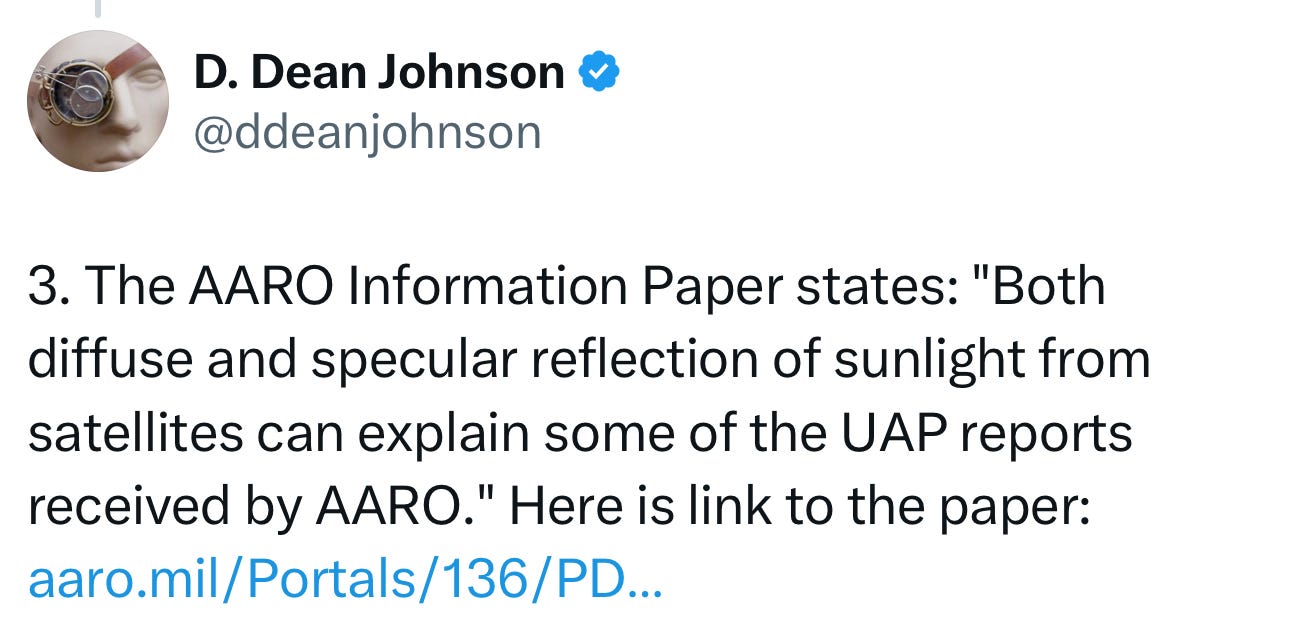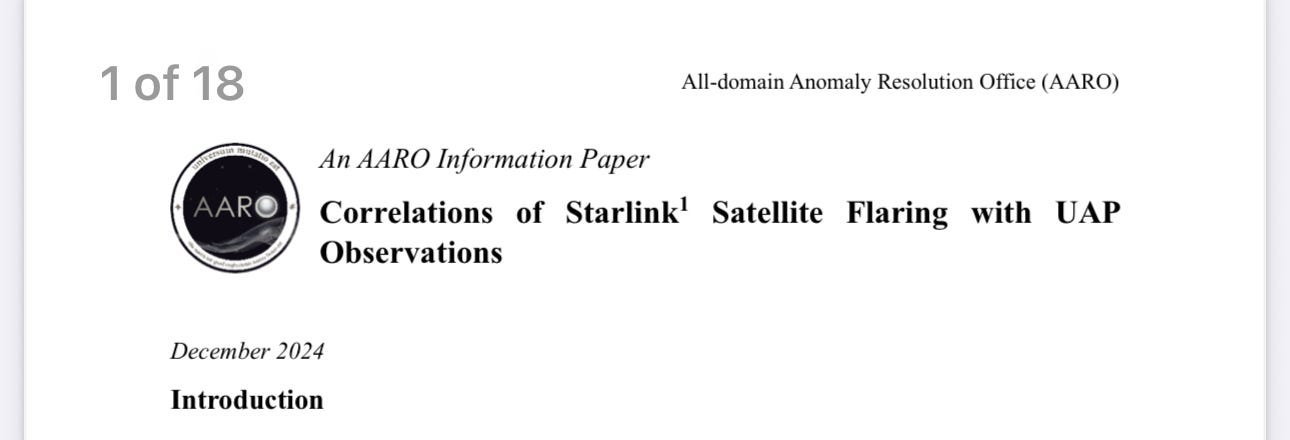“It’s Probably Just Starlink”: Why That’s Not Science – It’s Evasion
Written by UAP Files - Jimmy
The All-domain Anomaly Resolution Office (AARO) released a detailed technical paper in December 2024 explaining how Starlink satellite flares — glinting sunlight reflected off their mirrored surfaces — could account for many UAP/UFO sightings.
It’s quite thorough. Diagrams. Equations. Azimuths and elevation angles. At one point, I believe I blacked out and woke up in a trigonometry lecture.
And yet — for all its detail — something feels off. Not wrong in the data, but wrong in the assumption that explaining the light explains the experience.
Let me explain.
We already know sun reflects.
Let’s start with the obvious. Yes, the sky has become increasingly cluttered. Yes, we now have over 16,000+ satellites up there including defunct, Starlink and all kinds of classified stuff, and yes, they reflect sunlight in dazzling, sometimes disorienting ways. We know. The astronomy community has been talking about light pollution for years. Nobody disputes that.
But here’s the part where we part ways:
“The object zigzagged across the sky, pulsed with light, and responded as I focused my attention on it.”
“Ah. Yes. Classic Starlink.”
Really?
The Flat Earth of UAP Explanations
This is the equivalent of someone describing a profound dream, and you responding:
“Well, dreams are caused by REM cycles and neurochemical shifts.”
Yes, thank you — but you’ve explained the mechanism, not the meaning. You’ve flattened the human experience to fit a chart.
The AARO paper is impressive — don’t get me wrong. It’s necessary work. But when a pilot sees multiple lights moving in different directions, near a constellation, appearing to respond to attention or coordinate behaviour, the blanket response of “just a satellite flare” is, quite frankly, scientific laziness masquerading as scepticism.
Let’s entertain this for a moment in the language of “probability,” which the AARO paper leans on heavily:
If someone reports a light in the sky, and there are Starlink satellites visible at that time, then the probability increases that the observation correlates with known space objects.
Fair enough.
But here is the thing…
“So… let me get this right. You saw a bright orb zigzagging, it flashed when you spoke to it, and you felt… what, a kind of connection?”
“Yes.”
“And your first instinct was… Starlink?”
It would be funny if it weren’t so patronising.
The thing missing from this entire paper — and frankly, from much of the “UAP as optics” discourse — is us.
The observer.
The witness.
The fact that people are having profound, sometimes life-changing encounters — not with glints, but with moments that challenge their entire worldview. Something that pulses with intent, plays with geometry, or simply hovers with impossible stillness does not strike most people as a mirror on a stick. I’ve interviewed people who have seen and experienced just this. Presented hours of footage, archive reports connected to it and data that couldn’t be debunked (and they tried).
And yet the standard response is:
“You were probably confused.”
Let me be clear: That is pseudoscience.
When you dismiss data (in this case, emotional, psychological, or phenomenological data) because it doesn’t match your model, you’re not doing science — you’re doing selective storytelling with a lab coat on.
I’m not saying satellites can’t cause misidentifications. They absolutely can and do. But if we are to treat this topic seriously — and I hope AARO intends to — we must look beyond what reflects, and into what reflects us back.
If thousands of credible people are seeing something they feel is responding to them — something intelligent, even playful — and your response is, “Well, there was a Starlink nearby,” then forgive me, but that sounds more like evasion than explanation.
And if one day, we discover that consciousness really does interact with reality in ways we don’t yet understand, well — won’t we look silly for calling it a glint?






Well put Jimmy. Totes with you, and then some matey. After KirkPatrick's performance I get the feeling that he couldn't be bothered to even have plausible deniability about the BS he spouted, and so imho AARO is a disinformation channel methinks, sadly? Kirkpatrick told the Senate Armed Services Committee that his office has seen "no credible evidence thus far of extraterrestrial activity, off-world technology or objects that defy the known laws of physics." His replacement Kosloski has just stated that "it is important to underscore that, to date, AARO has not discovered any verifiable evidence of extraterrestrial beings, activity or technology." so just puking out more of the same, no? His overview is that "Many reports resolve to commonplace objects like birds, balloons and unmanned systems, while others lack sufficient data for comprehensive analysis," Kosloski said, adding that "only a small percentage of reports received by AARO are potentially anomalous." Swamp gas chinese spy balloon tastic mate! I wonder if they have commented on Jeremy Corbell and George Knapp's latest as allegedly the provenance is genuine and is unclassified if it's out there so should fall under their remit, no? We are disclosing regardless, courtesy of your good self mainly for me? Soooooooo much BS out there and the AI thing is not helping much either, so let's keep on keeping on I say and non illegitimi carborundum! Class as ever frankly!
AARO is a complete waste of time. No one trusts them and they lie.